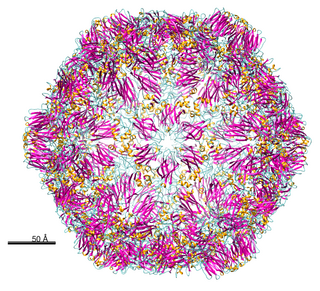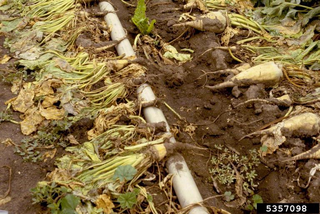External links
- ICTVdB - The Universal Virus Database: Beet distortion mosaic virus
- Family Groups - The Baltimore Method Archived 2013-03-30 at the Wayback Machine
| Beet distortion mosaic virus | |
|---|---|
| Virus classification | |
| Group: | Group IV ((+)ssRNA) |
| Family: | |
| Genus: | |
| Species: | Beet distortion mosaic virus |
| Synonyms | |
BtMV | |
Beet distortion mosaic virus is a plant pathogenic virus.
A satellite is a subviral agent that depends on the coinfection of a host cell with a helper virus for its replication. Satellites can be divided into two major classes: satellite viruses and satellite nucleic acids. Satellite viruses, which are most commonly associated with plants, are also found in mammals, arthropods, and bacteria. They encode structural proteins to enclose their genetic material, which are therefore distinct from the structural proteins of their helper viruses. Satellite nucleic acids, in contrast, do not encode their own structural proteins, but instead are encapsulated by proteins encoded by their helper viruses. The genomes of satellites range upward from 359 nucleotides in length for satellite tobacco ringspot virus RNA (STobRV).

Lettuce mosaic virus (LMV) is a typical potyvirus, which causes one of the major virus diseases of lettuce crops worldwide.

Potyvirus is a genus of positive-strand RNA viruses in the family Potyviridae. Plants serve as natural hosts. Like begomoviruses, members of this genus may cause significant losses in agricultural, pastoral, horticultural, and ornamental crops. More than 200 species of aphids spread potyviruses, and most are from the subfamily Aphidinae. The genus contains 190 species and potyviruses account for about thirty percent of all currently known plant viruses.

Begomovirus is a genus of viruses, in the family Geminiviridae. They are plant viruses that as a group have a very wide host range, infecting dicotyledonous plants. Worldwide they are responsible for a considerable amount of economic damage to many important crops such as tomatoes, beans, squash, cassava and cotton. There are 445 species in this genus.

Nepovirus is a genus of viruses in the order Picornavirales, in the family Secoviridae, in the subfamily Comovirinae. Plants serve as natural hosts. There are 40 species in this genus. Nepoviruses, unlike the other two genera in the subfamily Comovirinae, are transmitted by nematodes.

The Upstream pseudoknot (UPSK) domain is an RNA element found in the turnip yellow mosaic virus, beet virus Q, barley stripe mosaic virus and tobacco mosaic virus, which is thought to be needed for efficient transcription. Disruption of the pseudoknot structure gives rise to a 50% drop in transcription efficiency. This element acts in conjunction with the Tymovirus/Pomovirus tRNA-like 3' UTR element to enhance translation.
Arabis mosaic virus is a viral plant pathogen that is known to infect multiple hosts. The pathogen, commonly referred to as ArMV, is from the family Secoviridae, and it causes yellow dwarf of raspberry and is one of the causes of mosaic of rhubarb. Arabis mosaic virus infects multiple hosts, including strawberries, hops, hemp, grape, geraniums, raspberries, sugar beets, celery, horseradish, lilac, peach, and lettuces.
Beet mosaic virus (BtMV) is a plant pathogenic virus of the family Potyviridae.
Chickpea distortion mosaic virus is a plant pathogenic virus of the family Potyviridae.

Cucumber mosaic virus (CMV) is a plant pathogenic virus in the family Bromoviridae. This virus has a worldwide distribution and a very wide host range, having the reputation of the widest host range of any known plant virus. It can be transmitted from plant to plant both mechanically by sap and by aphids in a stylet-borne fashion. It can also be transmitted in seeds and by the parasitic weeds, Cuscuta sp. (dodder).
Pea enation mosaic virus (PEMV) is really two plant pathogenic viruses. The two RNAs of the disease are now categorised as two separate, mutualistic viruses:

Tomato mosaic virus (ToMV) is a plant pathogenic virus. It is found worldwide and affects tomatoes and many other plants.

Benyvirus is a genus of viruses, in the family Benyviridae. Plants serve as natural hosts. There are four species in this genus. Diseases associated with this genus include: BNYVV: rhizomania.
Beet Soil-Borne Mosaic Virus (BSBMV) is a plant pathogenic virus. It is a mosaic virus and a soil borne pathogen affecting beetroot.

Squash mosaic virus (SqMV) is a mosaic virus disease common in squash plants and other plants, including melons, of the family Cucurbitaceae. It occurs worldwide. It is transmitted primarily by beetles, including the leaf beetle, spotted cucumber beetle, and 28-spotted ladybird beetle, as well as some other beetles. Plants are infected by the saliva expelled by the beetles as they feed upon the plant. The beetles acquire the virus by feeding upon an infected plant and can retain the virus in their bodies for up to 20 days. Unlike some other mosaic viruses that infect squashes, SqMV is not spread by aphids. In melons it can be spread by seeds. The results are dark green mosaic, blistering, vein clearing, yellowing of leaves, and hardening. Symptoms include "pronounced chlorotic mottle, green veinbanding, and distortion of leaves". Fruits of infected plants are also affected, becoming mottled and misshaped. There are two strains of this virus: strain 1 has a greater effect on melons than squash while the opposite is true of strain 2.

Caulimovirus is a genus of viruses, in the family Caulimoviridae order Ortervirales. Plants serve as natural hosts. There are 12 species in this genus. Diseases associated with this genus include: vein-clearing or banding mosaic.
Polerovirus is a genus of viruses, in the family Solemoviridae. Plants serve as natural hosts. There are 26 species in this genus. Diseases associated with this genus include: PLRV causes prominent rolling of the leaves of potato and a stiff upright habit of the plants; necrosis of the phloem and accumulation of carbohydrates in the leaves.
Tolecusatellitidae is a incertae sedis ssDNA/ssDNA(+) family of biological satellites. The family contains two genera and 131 species. This family of viruses depend on the presence of another virus to replicate their genomes, as such they have minimal genomes with very low genomic redundancy.